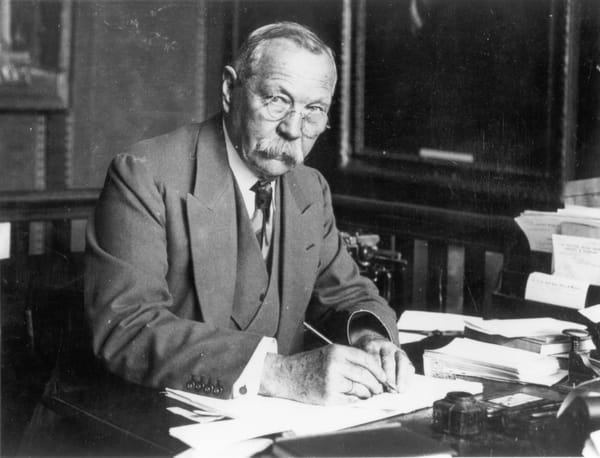Note 34: No longer sailing alone?
Social Media = Super-Soldier Serum?
I ran across a story this last week in the New York Times that served as a Rosetta Stone for what I’ve been feeling the past year:
Languishing is the neglected middle child of mental health. It’s the void between depression and flourishing — the absence of well-being. You don’t have symptoms of mental illness, but you’re not the picture of mental health either. You’re not functioning at full capacity. Languishing dulls your motivation, disrupts your ability to focus, and triples the odds that you’ll cut back on work. It appears to be more common than major depression — and in some ways it may be a bigger risk factor for mental illness.
…
Part of the danger is that when you’re languishing, you might not notice the dulling of delight or the dwindling of drive. You don’t catch yourself slipping slowly into solitude; you’re indifferent to your indifference. When you can’t see your own suffering, you don’t seek help or even do much to help yourself.
The rest of the article is worth a read, so give it a go.
This is the best description of my default mental state since the COVID pandemic began, and it’s helpful to give it an actual name. I’ve been able to somewhat manage my own “languishing” with distracting activities such as the holidays, the election, and some VR and video-gaming, but I always seemed to snap back to the dulled state as a default status. As I described to someone last week, it feels like being stuck in a rut, unable to get out, while time speeds on by. It’s not a fun place to be, and it’s good to know that it’s not a distinct phenomenon unique to me and any personal shortcomings. A lot of us seem to be the ubiquitous sheep that was making the social media rounds earlier in the week:
My latest attempt to escape my rut has been a multi-layer scheme. At the top of the layer is the dual recognition that the world’s beginning to open up and I need to take advantage of that, as well as the fact that I’ve lived on the banks of Lake Michigan for almost two decades now, and I’ve been criminally negligent in taking advantage of the Great Lake to the east of me.
So, to address those two issues, I signed up for a summer course on racing sailing at the Chicago Yacht Club. (More accurately, I signed up for a course that teaches me how to be a crew member on such a craft.) Given that my nautical knowledge only goes as far as being able to point out the port and starboard sides of a craft (I’ve forgotten what you call the front and back), I figure that this will do a decent job shaking me out of my comfort zone and forcing me to learn something brand new from the very start - something I haven’t done in some time. On the intrinsic motivation front, that’s pretty exciting.
And on the extrinsic motivation front, before classes start mid-next month, I also need to whip myself back into shape (ship-shape?). During the past year, I only had minimal success exercising - either getting out and about on walks or in VR swatting bubbles set to music. Aside from the underlying lethargy, it’s been tricky getting a routine going when weather isn’t cooperating or your exercise space is only available intermittently as contractors need that space to store things like toilets and cabinets. (Fortunately, all the construction is FINISHED as of yesterday!) So, in my quest to be something other than ballast (an inert heavy weight on a ship - I guess I know another term!), I’ve resumed going to the gym this week to work on burning off some fat (I could afford to lose a good 40 pounds gained over the past decade) as well as building up some strength and endurance so that my time on Lake Michigan doesn’t end up as time spent in Lake Michigan if I fall off a boat for a stupid reason. (And you don’t win races if you have to circle back to pick up lost crew.)
In addition to the physical and mental health benefits, I’m also trying to be more intentional using the exercise to build up some new social capital (more on this below) in the form of expanding my circle of acquaintances. Being a solo entrepreneur is an isolating experience, and my preexisting social circle has been withering over the past couple of years as people move, have kids, fall out of touch, etc. I figure that this may be a good opportunity for meeting a new circle of folks and expanding my network of contacts, which has traditionally been a challenge for middle-aged men. My main goal is to focus on becoming a competent crew member and using that competence as an angle to meet people by filling crew gaps on their boats in pursuit of a common competitive goal.
And who knows? Maybe in the pursuit of sailing fast, I end up chatting with a fresh-faced Chicago transplant having fun talking to people. Stranger things have certainly happened.
Bowling Alone: The Collapse and Revival of American Community
This will be an extended book report on the single book that’s monopolized my reading for the greater part of the past two weeks. Without further ado…
Bowling Alone: The Collapse and Revival of American Community (20th Anniversary Edition) by Robert Putnam (★★★★★): As I mentioned last week, I was reading this book because it’s a volume that I had heard summarized many times, but I’d never taken the opportunity to read it directly myself to see what precisely Putnam was saying about American social health and community involvement.
I’m very glad that I finally got around to giving it a read. While Putnam’s core message about the decline of American involvement in local communities and social settings was conveyed accurately by those quoting it, there’s a lot more value in the book that didn’t make it through the second-hand citations and throwaway references.
Bowling Alone is essentially an investigation into the history and formation of social capital in America in the 20th century. Originally published in 2000, the book is split into three major parts (and one minor part): measuring the decline in community involvement and social capital formation since the 1950s, proposing and evaluating various theories attempting to explain the growing personal isolationism of individual Americans, the problematic effects of declining participation in American life, and finally (the minor section) what to do about it. Putnam also included an additional chapter in this anniversary edition - penned during the middle of the COVID-19 pandemic - evaluating the claims he made two decades ago and discussing new elements influencing his story that did not exist in 2000, mainly social media and surveillance capitalism.
I’ve thrown around the term social capital above, so I should define it for readers who have not spent time in sociology or economics texts. I was introduced to the idea through the writings of Pierre Bourdieu:
Bourdieu saw social capital as a property of the individual, rather than the collective, derived primarily from one’s social position and status. Social capital enables a person to exert power on the group or individual who mobilises the resources. For Bourdieu social capital is not uniformly available to members of a group or collective but available to those who provide efforts to acquire it by achieving positions of power and status and by developing goodwill (Bourdieu, 1986). For Bourdieu social capital is irreducibly attached to class and other forms of stratification which in turn are associated with various forms of benefit or advancement.
Bourdieu framed social capital as accrued actual or virtual resources acquired by individuals or groups through the possession of “more or less institutionalized relationships of mutual acquaintance and recognition” (Bourdieu & Wacquant, 1992: 119). Therefore, social capital resides in the individual and is linked to social connections that a person can utilise for advancement.
For Bourdieu, social capital is manifested through benefits derived from social networks, however, the source of social capital stems from social, economic, and cultural structures that create differential power and status for specific individuals and not others. Power and status create taken-for-granted assumptions such as social norms that produce advantage. Social capital is therefore not so much about having a large social network but having social position that creates the potential for advantage from one’s social network.
Bourdieu’s conception is not the only take on the idea, but it’s the one that’s stuck with me, and is perfectly workable in the context of Bowling Alone.
In Bowling Alone, Putnam focuses on two kinds of social capital: bridging social capital that allows one to connect to other networks of individuals, and bonding social capital that intensifies relationships within an existing social network. He also introduces two types of social actors: the schmoozer who gets out to meet and chat with people, and the macher who gets their hands dirty and actually does something concrete. In the context of political activism, the schmoozer is the one greasing palms and kissing babies to build fraternity and goodwill, while the macher is the one in the back office drafting the policy and doing the less glamorous work to spend the political capital created by the schmoozer to actually enact change.
Since 1950, Putnam uses a wide variety of metrics to demonstrate that Americans declined to serve as either schmoozers or machers, and are instead becoming hermits inwardly focused on their personal lives to the exclusion of their community lives. In the second part of the book - and the best part in my opinion - he evaluates a variety of hypotheses - such as women entering the workforce, growing distances between homes and jobs, education, racial integration, and others - and emerges with two key culprits that explain the decline in community involvement: television and generational replacement.
Given that the book was published in 2000, the emergence of television was the less interesting of the two elements. Putnam evaluates the available information and determines that television viewing correlates with low civic participation in two ways. The first correlation is that controlling for all other factors, heavy television use is correlated with low civic participation, controlling for income, generation, education, etc. Secondly, between generations, television use is not distributed evenly (which makes sense if we’re looking at the 1950s onward from a technology adoption angle), and later generations are heavier television users than earlier ones. From a comparative perspective, younger television-hungry generations are less involved in their communities than older generations who didn’t integrate the technology into their lives so deeply. Nothing particularly surprising here, but it was good to see it empirically justified.
Where Putnam’s story gets really interesting is when he evaluates generations on their own. Rather than tell a simple decline narrative along the lines of younger people are just less involved than their forebearers, Putnam expands his historical view back through the entire 20th century and discovers that the generation of Americans born between 1910 and 1930 were massively more civically involved than the generations that preceded them, suggesting that the Great Depression and World War II may have a relevant role in later 20th century community health. Looking further back, Putnam sees similar patterns in the generation born before the American Civil War. Putnam’s thesis is that the community mobilization required to fight these conflicts not only on the battlefield, but also on the homefront, seeded local soils for increases in communitarian involvement decades later. Absent some great national effort that concretely enlists all members of a community, the story of the decline in civic life in the latter half of the 20th century becomes less about self-absorbed and lazy Boomers and GenX’ers, and more about two generations that never absorbed the same community-oriented ethos in a crucible of total warfare and great economic hardship. Putnam illustrates this by highlighting the trends of personal isolationism and social balkanization that was also prevalent in the latter 19th century.
Putnam closes out the original chapters by asking what can be done to increase civic involvement without poking a crisis severe enough to threaten an entire nation. He advocates that we follow the example of the early 20th century Progressives who - in the process of pushing a political reform agenda - engaged in issue-based community organization to push for a variety of changes. Shared issues served as the instigator that originally brought unconnected people together, and the networks that people formed while serving as activists often translated into social bonds that served as the foundation for later non-political neighborhood associations, fraternal organizations, and other local groups. The local chapter of the Women’s Christian Temperance Union becomes the basis for the local bridge clubs and bowling leagues decades later.
Putnam’s final chapter - written during the coronavirus pandemic - gestures toward some updated questions that should be asked within his social capital / community formation framework, but he doesn’t have the same level of data to match the rigor as he did twenty years before. The main lesson that he emphasizes in the 2020 chapter is that new technologies, increased political polarization, and changes in behavior over the past two decades are not distributed uniformly among the population, and much like the Super Soldier Serum from the pages of Captain America, these elements have a tendency to amplify what was already in hearts and minds (and pocketbooks) of community members as opposed to serving as a leveling agent that brings everyone along for the ride. (This is a very Bourdieu-like perspective on the subject as well.)
Overall, I’m very impressed with this book and it’s left me a lot to think about. I think that this demonstrates social science at its finest - Putnam isn’t content to just publish his story to a narrow academic community and does the hard work of finding alternative explanations for what he’s investigating and determining to what extent those competing hypotheses strengthen or dilute his own theory. I appreciate that he dived into additional history to add needed context to his story, even if it demolishes the mainstream notion that latter-day Americans are civically-inferior to their predecessors. While I’m not entirely sold that emulating the Progressives of the late 19th century is the entire playbook that we should be following to reinvigorate our communities (though it is a place to start, which many social scientists tend to omit), it’s useful to get our mental collective gears spinning to start to recognize and exploit opportunities to start rebuilding the necessary local foundations for productive social capital formation.
I’m a big fan of the book.
In terms of my overall reading goal, I remain one book ahead of schedule (31 of 101).
Interesting reads and watches
Europe seeks to limit use of AI in society (BBC)
Afghans Wonder ‘What About Us?’ as U.S. Troops Prepare to Withdraw (New York Times)
The humble shrub that’s predicting a terrible fire season (Ars Technica)
How the Smart Remote Lost Its Way (Wired)
NASA's Ingenuity helicopter makes first historic flight on Mars (Sky News)
Fleeing a Modern War, Syrians Seek Refuge in Ancient Ruins (New York Times)
Next week, this newsletter will get back to its roots in the year 3307, where I’ve been building social capital fighting pirates on behalf of an interstellar faction seeking to build new outposts for humanity in the Milky Way galaxy. We’ll tackle whether I’ve gotten over “the hump” of VR engagement and and what that means, both good and bad. Stay tuned, CMDRs!



